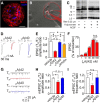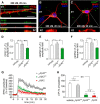Intracellular accumulation of amyloid-β (Aβ) protein plays a major role in Aβ-induced alterations of glutamatergic synaptic transmission and plasticity
- PMID: 25232124
- PMCID: PMC6705320
- DOI: 10.1523/JNEUROSCI.1201-14.2014
Intracellular accumulation of amyloid-β (Aβ) protein plays a major role in Aβ-induced alterations of glutamatergic synaptic transmission and plasticity
Abstract
Intracellular accumulation of amyloid-β (Aβ) protein has been proposed as an early event in AD pathogenesis. In patients with mild cognitive impairment, intraneuronal Aβ immunoreactivity was found especially in brain regions critically involved in the cognitive deficits of AD. Although a large body of evidence demonstrates that Aβ42 accumulates intraneuronally ((in)Aβ), the action and the role of Aβ42 buildup on synaptic function have been poorly investigated. Here, we demonstrate that basal synaptic transmission and LTP were markedly depressed following Aβ42 injection into the neuron through the patch pipette. Control experiments performed with the reverse peptide (Aβ42-1) allowed us to exclude that the effects of (in)Aβ depended on changes in oncotic pressure. To further investigate (in)Aβ synaptotoxicity we used an Aβ variant harboring oxidized methionine in position 35 that does not cross the neuronal plasma membrane and is not uploaded from the extracellular space. This Aβ42 variant had no effects on synaptic transmission and plasticity when applied extracellularly, but induced synaptic depression and LTP inhibition after patch-pipette dialysis. Finally, the injection of an antibody raised against human Aβ42 (6E10) in CA1 pyramidal neurons of mouse hippocampal brain slices and autaptic microcultures did not, per se, significantly affect LTP and basal synaptic transmission, but it protected against the toxic effects of extracellular Aβ42. Collectively, these findings suggest that Aβ42-induced impairment of glutamatergic synaptic function depends on its internalization and intracellular accumulation thus paving the way to a systemic proteomic analysis of intracellular targets/partners of Aβ42.
Keywords: 6E10; amyloid-β protein; autaptic hippocampal neurons; intraneuronal accumulation; synaptic transmission; whole-cell LTP.
Copyright © 2014 the authors 0270-6474/14/3412893-11$15.00/0.
Figures







Similar articles
-
Alpha4beta2 nicotinic acetylcholine receptors are required for the amyloid beta protein-induced suppression of long-term potentiation in rat hippocampal CA1 region in vivo.Brain Res Bull. 2008 Sep 30;77(2-3):84-90. doi: 10.1016/j.brainresbull.2008.06.005. Epub 2008 Jul 9. Brain Res Bull. 2008. PMID: 18602971
-
Effect of Aβ Oligomers on Neuronal APP Triggers a Vicious Cycle Leading to the Propagation of Synaptic Plasticity Alterations to Healthy Neurons.J Neurosci. 2020 Jul 1;40(27):5161-5176. doi: 10.1523/JNEUROSCI.2501-19.2020. Epub 2020 May 22. J Neurosci. 2020. PMID: 32444385 Free PMC article.
-
Neuromodulatory Action of Picomolar Extracellular Aβ42 Oligomers on Presynaptic and Postsynaptic Mechanisms Underlying Synaptic Function and Memory.J Neurosci. 2019 Jul 24;39(30):5986-6000. doi: 10.1523/JNEUROSCI.0163-19.2019. Epub 2019 May 24. J Neurosci. 2019. PMID: 31127002 Free PMC article.
-
Soluble oligomers of the amyloid beta-protein impair synaptic plasticity and behavior.Behav Brain Res. 2008 Sep 1;192(1):106-13. doi: 10.1016/j.bbr.2008.02.016. Epub 2008 Feb 17. Behav Brain Res. 2008. PMID: 18359102 Free PMC article. Review.
-
Physiological Roles of β-amyloid in Regulating Synaptic Function: Implications for AD Pathophysiology.Neurosci Bull. 2023 Aug;39(8):1289-1308. doi: 10.1007/s12264-022-00985-9. Epub 2022 Nov 28. Neurosci Bull. 2023. PMID: 36443453 Free PMC article. Review.
Cited by
-
Intraneuronal Aβ accumulation induces hippocampal neuron hyperexcitability through A-type K(+) current inhibition mediated by activation of caspases and GSK-3.Neurobiol Aging. 2015 Feb;36(2):886-900. doi: 10.1016/j.neurobiolaging.2014.10.034. Epub 2014 Nov 4. Neurobiol Aging. 2015. PMID: 25541422 Free PMC article.
-
Synaptic and synchronic impairments in subcortical brain regions associated with early non-cognitive dysfunction in Alzheimer's disease.Neural Regen Res. 2026 Jan 1;21(1):248-264. doi: 10.4103/NRR.NRR-D-24-01052. Epub 2025 Jan 29. Neural Regen Res. 2026. PMID: 39885666 Free PMC article.
-
Unravelling the role of amino acid sequence order in the assembly and function of the amyloid-β core.Chem Commun (Camb). 2019 Jul 18;55(59):8595-8598. doi: 10.1039/c9cc03654g. Chem Commun (Camb). 2019. PMID: 31276123 Free PMC article.
-
Increased excitability of dentate gyrus mossy cells occurs early in life in the Tg2576 model of Alzheimer's disease.Alzheimers Res Ther. 2025 May 15;17(1):105. doi: 10.1186/s13195-025-01747-1. Alzheimers Res Ther. 2025. PMID: 40375112 Free PMC article.
-
Next Generation Therapeutic Strategy for Treatment and Prevention of Alzheimer's Disease and Aging-Associated Cognitive Decline: Transient, Once-in-a-Lifetime-Only Depletion of Intraneuronal Aβ (iAβ) by Its Targeted Degradation via Augmentation of Intra-iAβ-Cleaving Activities of BACE1 and/or BACE2.Int J Mol Sci. 2023 Dec 18;24(24):17586. doi: 10.3390/ijms242417586. Int J Mol Sci. 2023. PMID: 38139415 Free PMC article.
References
-
- Attar A, Ripoli C, Riccardi E, Maiti P, Li Puma DD, Liu T, Hayes J, Jones MR, Lichti-Kaiser K, Yang F, Gale GD, Tseng CH, Tan M, Xie CW, Straudinger JL, Klärner FG, Schrader T, Frautschy SA, Grassi C, Bitan G. Protection of primary neurons and mouse brain from Alzheimer's pathology by molecular tweezers. Brain. 2012;135:3735–3748. doi: 10.1093/brain/aws289. - DOI - PMC - PubMed
Publication types
MeSH terms
Substances
LinkOut - more resources
Full Text Sources
Other Literature Sources
Miscellaneous
